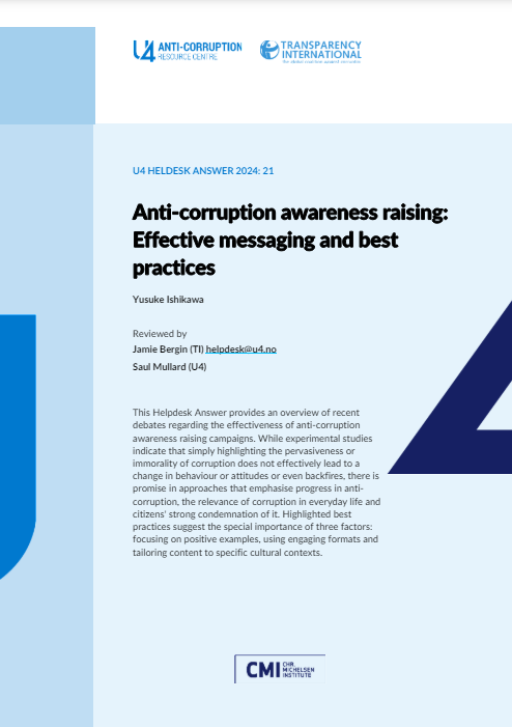- Home
- Anti-Corruption Helpdesk
- Anti-corruption awareness raising: Effective messaging and best practices
Anti-corruption awareness raising: Effective messaging and best practices

This Anti-Corruption Helpdesk brief was produced in response to a query from a U4 Partner Agency. The U4 Helpdesk is operated by Transparency International in collaboration with the U4 Anti-Corruption Resource Centre based at the Chr. Michelsen Institute.
Query
Please summarise the analytical debate on what sort of anti-corruption awareness raising campaigns work and provide any good practices of effective awareness campaigns.
Summary
This Helpdesk Answer provides an overview of recent debates regarding the effectiveness of anti-corruption awareness raising campaigns. While experimental studies indicate that simply highlighting the pervasiveness or immorality of corruption does not effectively lead to a change in behaviour or attitudes or even backfires, there is promise in approaches that emphasise progress in anti-corruption, the relevance of corruption in everyday life and citizens' strong condemnation of it. Highlighted best practices suggest the special importance of three factors: focusing on positive examples, using engaging formats and tailoring content to specific cultural contexts.
Main Points
- Various experimental studies indicate awareness raising messages emphasising the pervasiveness of corruption and its illegality or illegitimacy do not significantly reduce demands for and acceptance of bribes, increase reporting rates or alter attitudes towards (anti-)corruption.
- While a limited number of experimental studies suggest that messages emphasising corruption control may have positive effects, others caution against emphasising government led reforms, particularly when citizens have low confidence in government effectiveness.
- Some experimental studies suggest that messages emphasising the relevance of corruption in everyday life and citizens' strong condemnation of it can discourage citizens from bribing and encourage them to report corruption.
- The Integrity Icon initiative operating in several countries, which employs a ‘naming and faming’ approach, attests to the importance of emphasising positive trends to curb corruption.
- Video campaigns in Greece and Ukraine showcase the effectiveness of anti-corruption awareness campaigns that reach targets in an entertaining way. Tilapia Da Cartoonist, a meme-based anti-corruption campaign in Ghana, suggests that contextualised awareness raising campaigns can effectively and attractively convey campaigners’ messages about (anti-)corruption to a local audience.
Contents
Introduction
Effective anti-corruption messages
Message 1: Pervasiveness of corruption
Message 2: Immorality or negative consequences of corruption
Message 3: Progress against corruption
Message 4: Local relevance of (anti-)corruption
Best practices
Integrity Icon campaign
Video edutainment
Cartoon campaigns
Conclusion
References
Authors
Yusuke Ishikawa
Reviewed by
Jamie Bergin (TI) [email protected]
Saul Mullard (U4)
Date
03/05/2024

